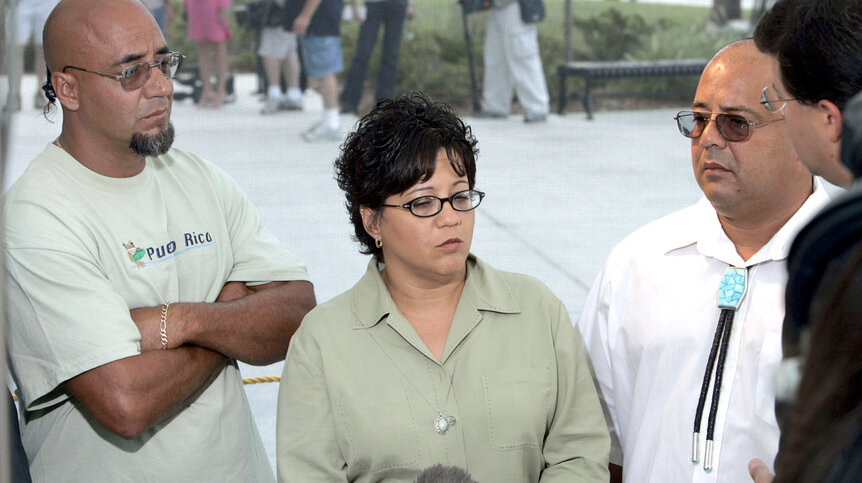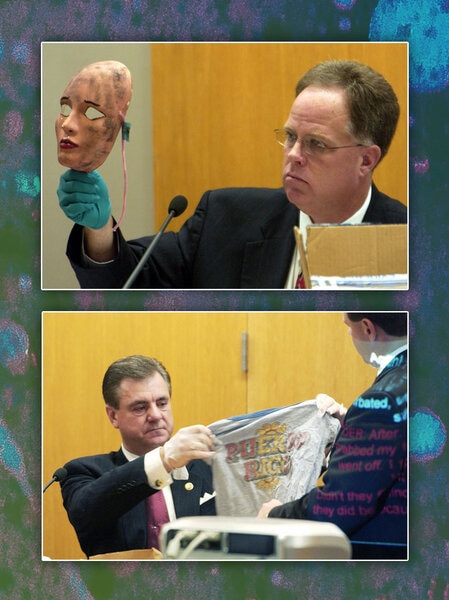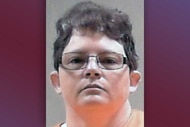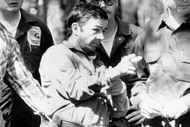Create a free profile to get unlimited access to exclusive videos, breaking news, sweepstakes, and more!
What Led To Serial Killer Dennis 'BTK' Rader's Capture After He Evaded Authorities For More Than 30 Years?
For three decades, Wichita's sadistic serial killer known by the moniker "BTK" terrorized the community and evaded authorities, but his own need for attention would ultimately be his demise.
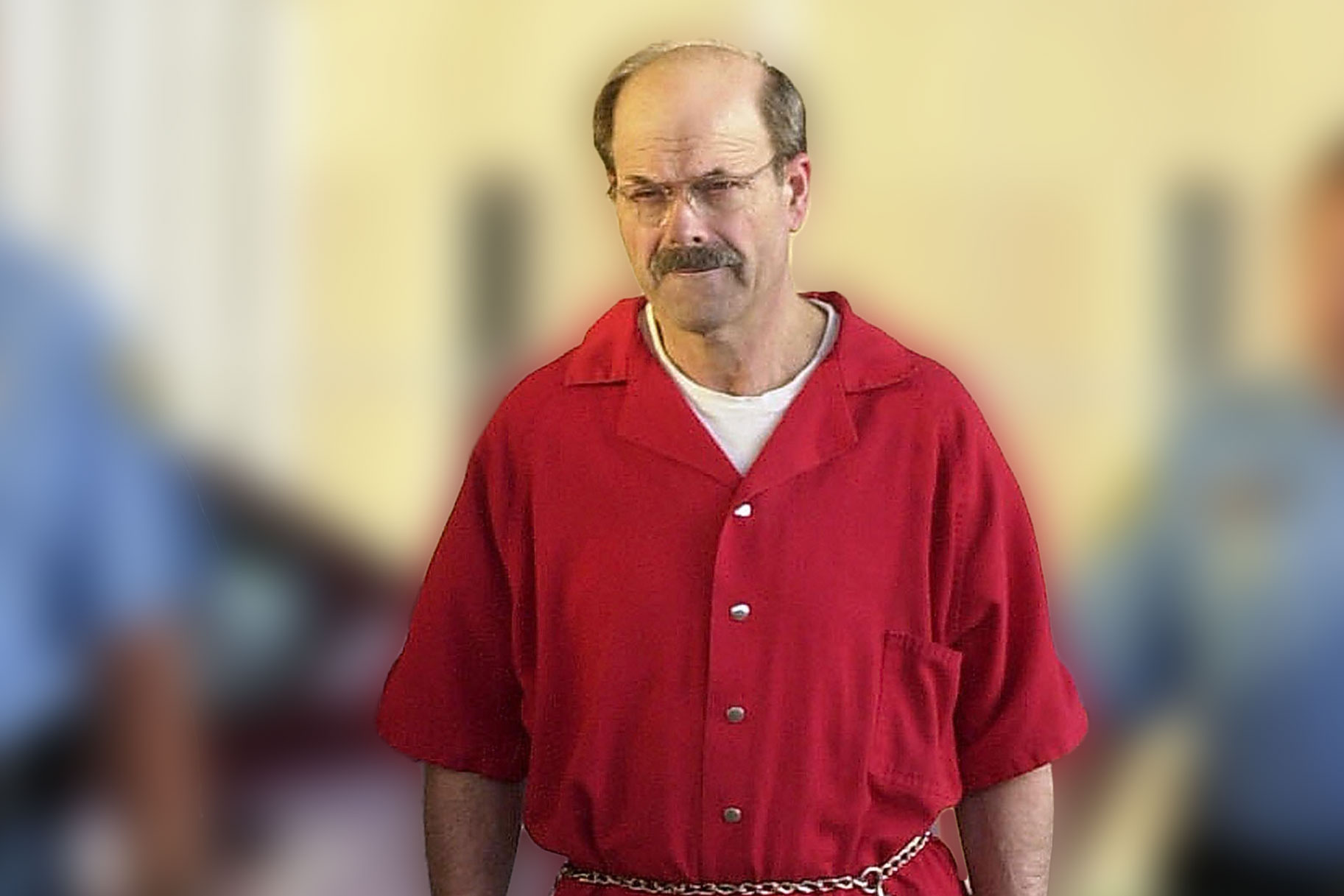
For more than 30 years, Wichita’s notorious serial killer managed to evade authorities — taunting investigators and local media over the years with cryptic letters and crime scene photos as his body count continued to rise.
The killer even gave himself his own nickname, “BTK.”
“The code words for me will be … Bind them, Torture them, Kill them, B.T.K.,” the mysterious killer wrote at the end of a 1974 letter found in the Wichita Public Library by The Wichita Eagle, after the newspaper staff had been led there by directions from BTK himself, according to Fox News.
The terror began earlier that year when BTK broke into the home of Julie and Joseph Otero and slaughtered the parents and their two youngest children, 9-year-old Joey and 11-year-old Josephine, while the couple’s three older children had been at school.
Over the next two decades, BTK’s list of victims grew until he murdered his tenth and final victim in 1991. Dolores Davis was murdered inside her home after the killer threw a cinderblock through her sliding glass door, killed her, then dumped her body underneath a bridge.
For years after that, the killings stopped and BTK remained eerily silent until a 30th anniversary news account of the Otero killings stirred up his homicidal feelings once again and he began to taunt police.
But this time, investigators would discover key evidence that led them straight to the murderer: a then 59-year-old church council president and former Boy Scout leader named Dennis Rader.
Rader pleaded guilty in 2005 to 10 counts of first-degree murder for claiming the lives of 10 people — who he chillingly referred to in court as his “projects” — after defense attorneys said the evidence against him was too “solid” to refute, NBC News reported.
But just what evidence finally led to the elusive killer’s capture?
‘All-American’ Boy
While many killers have trauma in their past, Rader doesn’t fit the typical mold.
“He was an all-American boy, the oldest of four boys in his family. He had an intact family and played on his farm,” Dr. Katherine Ramsland, a professor of forensic psychology who corresponded with Rader for more than a decade, said in A&E’s “BTK: Confessions of a Serial Killer.”
Rader grew up in Wichita, Kansas and while his father, a plant operator at a utility company, was strict, Rader’s friends told The New York Times that he was never cruel.
“Raders are a little bit stubborn, but not mean,” Rader’s first cousin Lee Rader told the outlet in 2005.
Rader spent his childhood playing cops and robbers with other children in the neighborhood, reading comic books, and visiting the local dime store. In a grade-school reunion publication known as the “Riverview Round-Up,” Rader reflected on his favorite memories from his school days, writing that he had loved recess, story time, last days of school, snowball fights broken up by the principal, art class, lunch, and an old merry-go-round.
In many ways his childhood seemed like a quintessential Midwest upbringing, but Ramsland, the author of "Confession of a Serial Killer: The Untold Story of Dennis Rader, the BTK Killer,” told Oxygen.com in 2018 that his mother had “humiliated him several times” and that he had always been “thrown off by women in charge.”
“Teachers, girls he liked made him feel completely off balance and he hated that, so there’s a development through his life of his need to keep women under control,” she said.
Establishing Himself As A Family Man
After graduating from high school, Rader tried college before dropping out and joining the Air Force, where he worked repairing wire and antenna systems.
He returned to the Wichita community where he grew up in 1970 and married Paula Dietz, a woman who had once gone to the same high school, the following year.
The couple went on to have two children, Brian and Kerri. They lived in a three-bedroom ranch house with their family dog. A treehouse Rader had built with his own hands was nestled in the backyard.
“Most of the time [my father] was even-keeled and kind and warm,” his daughter Kerri Rawson told ABC News in 2019.
Yet Rawson recalled that sometimes her father “could be very firm or have flashes of anger” that she wasn’t expecting.
Rader volunteered with the Boy Scouts, was a regular at church each Sunday, went back to college to earn a bachelor’s degree in criminal justice from Wichita State University, and worked as a supervisor at the security company ADT.
“He was deeply competent, organized, and good at what he did, but he was a taskmaster,” former coworker Rick Carr told The Times. “He came in with the attitude: you’re here to get the job done, and I’m not here to be somebody’s pal.”
What Rader’s own family didn’t know was that he was also living a double life as a sadistic killer.
BTK’s Victims
The first killings attributed to Rader were the slaughter of four members of the Otero family on Jan. 15, 1974. Rader entered the family’s home after their three oldest children had already gone to school and systemically killed Joseph Otero, 38, his wife Julie, 34, and their 11-year-old daughter, Josephine, and 9-year-old son, Joe.
“The whole family just panicked on me. I worked pretty quick,” he’d later say in court while pleading guilty in 2005, according to NBC News. “I strangled Mrs. Otero. She passed out. I thought she was dead. I strangled Josephine. She passed out. I thought she was dead. Then I went over and put a bag on Junior’s head.”
Rader said he later returned to strangle Julie again to make sure she was dead and had tried to have her husband was comfortable as possible before the slaying, after realizing Joseph had cracked a rib in a car accident, according to CBS News.
Rader said he made the decision to “put them down” after realizing he hadn’t worn a mask and the family would be able to identify him.
Josephine was found partially clothed, hanging from a sewer pipe in the basement of the family’s home. Although there had been no sexual assault, a semen stain was found near the body. The bodies were discovered later that day when the three older children came home from school and made the grisly discovery.
“I ran down the hall, went in their bedroom and saw my mother on the bed, my father on the floor, and my heart just got ripped out of my chest. My life changed instantly,” their son Charlie Otero would later tell ABC News.
Ramsland told Oxygen.com that Rader had targeted the family after seeing Julie and Josephine together because he had a “mother/daughter fantasy.”
That same year, Rader attacked 21-year-old Kathryn Bright and her younger brother, Kevin, on April 4, 1974.
Kevin — who was 19 years old at the time of the attack — later told CNN the pair had entered Kathryn’s home and were passing a bedroom when they heard a voice say, “Hold it right there.” They turned and saw a man with a gun. Rader told the siblings he didn’t want to hurt them and was only looking for money and a car.
He forced Kevin to tie his sister up in a bedroom and then Rader tied up Kevin himself. He returned a short time later and tried to strangle him with a knotted stocking, but Kevin “jumped” to his feet, causing Rader to pull out a gun and shoot him.
Kevin said he “played like I was dead” until Rader left the room, then he ran out of the house to get help, but it would be too late for his sister. Kathryn was found in the home stabbed in the abdomen and strangled to death.
A few years later on March 17, 1977, Rader claimed his next victim, 26-year-old Shirley Vian. Vian’s 5-year-old son, Steve Relford, unwittingly let the killer into the family’s home after Rader had knocked on the door, according to CNN.
Rader then locked Relford and his two siblings in the bathroom, while he bound Vian’s arms with tape, placed a plastic bag over her head, and tied a rope around her neck.
Relford said he’s still haunted to his day by seeing his mother “laying face down with a plastic bag over her head, a rope tied around her neck, all the fingers in her hand broken, her hands taped behind her back.”
Ramsland told Oxygen.com that Rader had targeted another victim that day — a women he had seen on campus and followed home on a different occasion — but she wasn’t home at the time and he didn’t want to “waste his opportunity” so he turned his focus to Vian after seeing her son on the street.
Later that year, Rader also killed 25-year-old Nancy Fox. In court, Rader said he had been “trolling through the area” and noticed Fox go into her house one night. After doing “a little homework” on who she was and where she worked, Rader returned to her duplex and strangled her to death with a pair of stockings, according to CBS News.
The next day he called 911 to anonymously report the homicide.
“You will find a homicide. 843 South Pershing. Nancy Fox,” he told the dispatcher, according to ABC News.
For years, Rader went quiet until he struck again on April 27, 1986, killing his 53-year-old neighbor, Marine Hedge. Hedge, who lived just six doors down from Rader’s own home, was strangled to death with a pair of pantyhose before her body was dumped along a dirt road.
The killing horrified Rader’s 6-year-old daughter Kerri, who began to have night terrors.
“I would wake up screaming, sitting up in bed, and my mom was always the one that would come comfort [me],” she said. “She would sit there and I would say, ‘There’s a bad man in my house’ and she’s like, ‘No, there’s no bad man in your house.’”
Later that year, Rader would also take the life of 28-year-old Vicki Wegerle during his lunch hour. Wegerle was found strangled to death on her bed on Sept. 16, 1986 with her 2-year-old son still in the home.
According to Ramsland, Rader “just missed” Wegerle’s husband who had been coming home to have lunch with his family.
The killings stopped once again until Jan. 19, 1991 when Rader took his final victim, 62-year-old Dolores Davis. Davis had been bound with pantyhose and strangled to death.
Long Stretches Between Kills
Rader killed 10 people over two-decades, but he often went years between kills, something criminologist Scott Bonn, PhD, called “very atypical” of a serial killer.
"Most serial killers don't have these lengthy, extensive periods between their killings," Bonn, who wrote the book “Why We Love Serial Killers: The Curious Appeal of the World’s Most Savage Murders,” told Oxygen.com in 2018. "Most of them really, really escalate and oftentimes, that is what leads to their undoing."
While Ramsland told Oxygen.com that Rader was “always looking” for his next victim, he had to wait until he had the opportunity to carry out the murder, especially as his demands as a father, husband, and employee continued to grow.
“He had to do this carefully and it had to be when he had pockets of opportunity that allowed him to pretend he was doing something else like library research for a course he was taking or being out of town or going overnight in a Boy Scouts Camping trip,” she said. “He always had to have a cover story.”
Rader provided Ramsland of a list of 55 “projects” or potential victims he had once targeted that included specific details about the targets and what he’d like to do them if he had the time.
“It’s not like he was inactive during those periods of time. It’s that he didn’t have all the right circumstances to go forward with something,” she said.
Both Bonn and Ramsland said Rader also had an active fantasy life that allowed him to re-live his crimes between kills.
According to Bonn, Rader used to cut out magazine pictures of naked women and dress up dolls in trophies he had taken from his victims’ houses.
“He told me in no uncertain terms in our correspondence that this enabled him to delay his killings,” Bonn said.
When investigators raided his home and office, they found a treasure trove of Polaroid pictures of his victims. But some of the photos were also of Rader himself in various forms of bondage and clothing, according to Oxygen’s “Mark Of A Serial Killer.” Rader liked to experiment on himself with “auto-erotic activity,” which gave him a thrill and satisfied a need within him.
Power Control Killer
Bonn described Rader as a power-control killer who got his pleasure from stalking a victim, then binding and torturing them rather than the kill itself.
"It was all about the process of killing and it was almost like foreplay for sex, where it would lead up to the ultimate moment where he would kill them, but that's not really what he lived for," he said. "What he lived for was the process.”
Rader was able to get the same thrill through the power and control he found in his jobs, first at a security company and later as a compliance officer in Park City, Kansas, where he was known for being a stickler for the rules.
Barbara Walters remembered challenging Rader over a $25 ticket he had given her in 1998 after Rader said her dog had been running loose. When Rader came to court to appear on the matter, he had a lengthy file and video evidence to support his case.
“He looked for absolutely everything, and he must have enforced every rule there ever was—just because he could I guess,” Walters told The New York Times.
Victimology
When it came to his victims, Ramsland told Oxygen.com that he often looked for a petite woman he could easily overpower and subdue, so he could carry out his preferred killing method of strangulation. He tended to favor women who were alone and didn’t own dogs after he had “made some mistakes in that regard.”
As he aged, his victims also got older.
“When he first came out of the Air Force, he was very fit, very different from the kind of image we get of him from his arrest photos and court photos,” Ramsland said. “As he aged, he became aware of losing his strength and whatnot, so you see him going after more elderly women as final victims.”
Taunting Media And Police
Rader was known to taunt police and the media over the years in a terrifying game of cat-and-mouse where he challenged authorities, provided proof of his kills, and referred to himself as a “monster.”
“I’m sorry this happen to society,” he wrote in the 1974 letter found in the Wichita Public Library, according to Fox News. “They are the ones who suffer the most. It hard to control myself, You probably call me ‘psychotic with sexual perversion hang-up.’ Where this monster enter my brain I will never know. But, it here to stay. How does one cure himself? If you ask for help, that you have killed four people, they will laugh or hit the panic button and call the cops.”
BTK also made it clear that he wanted attention for his brazen crimes, writing in a letter sent to KAKE-TV station in 1978, “How many do I have to kill before I get my name in the paper or some national attention?”
A Killer’s Identity Is Revealed
It was that need to be noticed that would eventually lead to his arrest. Thirty years after the Otero slayings in 2004, The Wichita Eagle ran a piece on the anniversary and suggested that BTK — who had been dormant for years — was either dead or in prison.
Rader would later say, “That really stirred it.” He couldn’t fight the urge to reach out to the paper and sent a letter under the name “Bill Thomas Killman” or “BTK” on the return address, along with photos of Wegerle from the crime scene.
“I’ll never forget that day,” former Wichita Police Det. Kelly Otis told ABC News.
From there, Rader continued to taunt authorities sending messages to The Wichita Eagle and KAKE-TV and once leaving a cereal box along the side of a road with grisly clues inside.
“He thought this is a great joke,” Ramsland told the news outlet. “He got these dolls dressed them to look like his victims, put them into the boxes with…some of the victims’ items.”
But his fatal error would prove to be a message in a cereal box he dropped into the bed of a Home Depot employee’s truck asking police whether they would be able to trace him if he sent them a floppy disk and asking them to “be honest.”
Law enforcement responded by placing an ad in the paper saying, “Rex, it’ll be OK.” Confident that the police would never lie to him, Rader sent the floppy disk to detectives. It wasn’t long before they were able to use metadata stored within the disk to trace it back to a computer registered to Christ Lutheran Church and a user named Dennis.
Rader had been the president of the church at the time and quickly became authorities’ top suspect. Before arresting Rader, they got a search warrant to secretly access Rawson’s DNA taken from annual pap smears she got at her college’s health center and compared the sample to DNA evidence found at the crime scenes, ABC News reported.
After more than three decades, investigators knew they had their killer. Rader was arrested on Feb. 25, 2005 on his way home to have lunch with his wife — who would later divorce him after the shocking news came to light.
“Once he raised his head again and started gaming again, taunting the police—that’s a very positive development and breeds new life into this case,” retired FBI profiler Gregg McCrary told NBC News. “If he had been incommunicado and had not reached out, this case may have never been solved.”
Before his arrest, Ramsland told Oxygen.com that Rader had been planning another kill and had even picked out his 11th victim.
He attempted to carry out the “elaborate” attack in 2004 but when he arrived on the woman’s street, he found a construction crew on the street outside her home and had to abort his plans.
“If he hadn't been arrested he would have carried out the 11th one,” she said, adding that Rader told her the complication had just postponed his plans.
Rather than face a lengthy trial, Rader pleaded guilty to all 10 counts of murder against him in June of 2005, recounting the grisly details of each murder with little emotion.
His defense attorney, Steve Osburn, would later tell NBC News Rader agreed to plead guilty because of the wealth of evidence against him, including his own confession, DNA evidence, and the “personal trophies” he had kept from his victims.
“From a legal standpoint, we had nothing to work with,” Osburn said.
Today, Rader is serving out a life sentence without the possibility of parole for 175 years in the El Dorado Correctional Facility.



